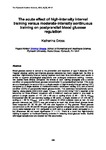The acute effect of high-intensity interval training versus moderate-intensity continuous training on postprandial blood glucose regulation
| dc.contributor.author | Gross, K. | |
| dc.date.accessioned | 2019-05-17T10:50:40Z | |
| dc.date.available | 2019-05-17T10:50:40Z | |
| dc.date.issued | 2015 | |
| dc.identifier.citation |
Gross, K. (2015) 'The acute effect of high-intensity interval training versus moderate-intensity continuous training on postprandial blood glucose regulation', The Plymouth Student Scientist, 8(2), p. 29-47. | en_US |
| dc.identifier.issn | 1754-2383 | |
| dc.identifier.uri | http://hdl.handle.net/10026.1/14096 | |
| dc.description.abstract |
Blood glucose control is central to the prevention and treatment of type 2 diabetes (T2D). Regular physical activity can improve glucose tolerance but many people lack the time to exercise. High-intensity interval training requires much less time commitment and results in similar or superior physiological adaptations over prolonged endurance training. However, few studies have directly compared the effects of both training strategies and a control condition on postprandial blood glucose concentration in a standardized manner. This study aims to investigate the acute effect of a single session of high-intensity interval training (HIIT) compared to a single session of moderate-intensity continuous training (CT) and a control condition (CON) on postprandial blood glucose levels. Five sedentary-recreationally active, healthy, young adults (23.6 ± 3.51 years, VO2peak = 33.8 (± 5.0) ml·kg-1·min-1) reported to the laboratory on three different occasions with a minimum wash-out period of one week to perform a single session of HIIT (10 x 60 sec of cycling efforts at 90 – 100 % VO2peak interspersed with 60 sec recovery cycling at 30 watts), a single session of CT (45 min of cycling at ~ 60 % VO2peak), and a CON session in which subjects were at rest. An oral glucose tolerance test (OGTT) was performed after each trial where blood glucose levels were measured 30, 60, 90 and 120 min after ingestion of 75g glucose. Blood glucose concentration at 30, 60 and 90 min post glucose ingestion and glucose area under the curve (AUC) were reduced after HIIT compared to CON and to a greater extent compared to CT, but differences did not reach significance (P ≥ 0.05). There is a trend that high-intensity training is superior to moderate-intensity exercise in reducing blood glucose levels. Studies with larger sample sizes are needed test this assumption. | en_US |
| dc.language.iso | en | en_US |
| dc.publisher | University of Plymouth | |
| dc.rights | Attribution 3.0 United States | * |
| dc.rights.uri | http://creativecommons.org/licenses/by/3.0/us/ | * |
| dc.subject | Blood glucose control | en_US |
| dc.subject | type 2 diabetes (T2D) | en_US |
| dc.subject | high-intensity interval training | en_US |
| dc.subject | physical activity | en_US |
| dc.subject | glucose tolerance | en_US |
| dc.subject | young adults | en_US |
| dc.subject | oral glucose tolerance | en_US |
| dc.title | The acute effect of high-intensity interval training versus moderate-intensity continuous training on postprandial blood glucose regulation | en_US |
| dc.type | Article | |
| plymouth.issue | 2 | |
| plymouth.volume | 8 | |
| plymouth.journal | The Plymouth Student Scientist |



